I noticed a decoratively marked black-and-white pollinator, studiously visiting flowers on our lavender bushes last week. I had not seen one of these unusually marked insects before, but guessed that it might be a solitary bee.
When checking up on it I was surprised to learn that some solitary bees are kleptoparasitic (or cleptoparasitic), that is they lay their eggs in the nests of other bees, hence their common name: cuckoo bee. After looking at photos of South African solitary bees, I concluded that the lovely looking bee that visited our lavender plants is likely to be one of the cuckoo bees.
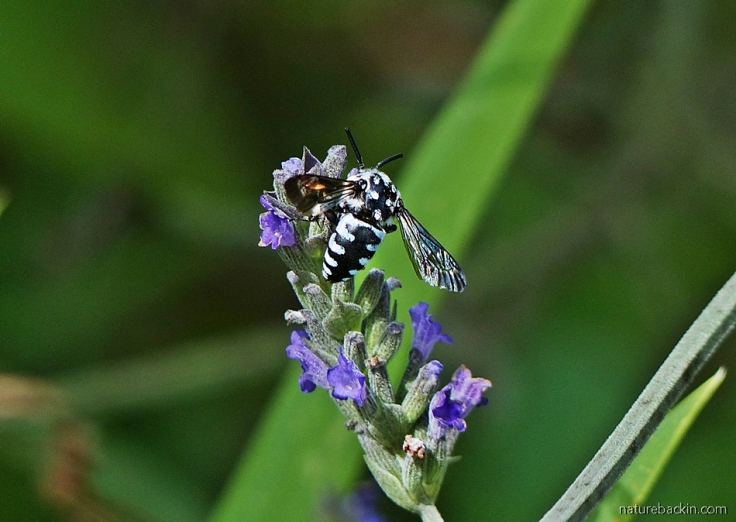
There are estimated to be 20 000 to 25 000 bee species worldwide, with over 1000 bee species in South Africa. Only a very few of these are social bees, including the honey bee, and most are solitary bees. Although there are some species of solitary bees that nest gregariously, that is in colonies, even then each female solitary bee independently constructs her own nest.
Solitary bee species have varying nest-building behaviours. Nests may be made in pre-existing cavities such as in hollow reeds, or in tunnels in wood or stalks that have been made and abandoned by other insects. Some species, such as carpenter bees, make their own tunnels in wood. Carder bees make external nests using plant material or partition their nests with plant fibres. Daubers make and partition their nests out of mud or resin. Others, known as mining bees, make or use tunnels in the ground.
Solitary bee nests consist of a series of chambers that are partitioned off from each other. The female fills each chamber with a mixture of nectar and pollen and lays an egg in each chamber. She does this sequentially sealing and partitioning each chamber as she goes. Some solitary bees, known as leaf-cutters, line and partition their nests with small fragments of leaf. Some gardeners, ignoring the fact that the pollinating services of bees are invaluable, eradicate leaf-cutter bees, even though the tidy notches the bees cut from leaves do not harm the plants. Other species of solitary bees partition their nests with resin, wood fragments, fine plant hairs/fibres, or mud.
When the eggs hatch, the bee larvae feed on their supply of nectar and pollen, they then pupate before emerging, usually in the spring as adult bees, whereupon they mate, the females nest, and the cycle continues.

Of course, cuckoo bees do not make nests at all. Instead, after mating, a female cuckoo bee looks for newly completed nests made by other species of bees. She waits for the host female to go away and then opens the nest and lays her eggs inside. When her faster-developing eggs hatch, the larvae are equipped with jaws to eat or kill the host eggs and larvae, and then they remain in the nest and consume the stash of nectar and pollen the host female left there for her own young
Bees (Anthophila) are divided into ten families, with six of these occurring in sub-Saharan Africa. I realise that a little bit of knowledge is dangerous thing, but as far as I could figure out, the cuckoo bee visiting our lavender flowers is a member of the Megachilidae family of long-tongued solitary bees. Megachilidae bee species can be anything from 3 mm to 22 mm in size. Megachilidae collect pollen on hairs on their abdomens and do not have pollen baskets on their legs, as do honey bees. Although Megachilidae are often referred to as leaf-cutters, in fact species in this family include also carpenter bees, daubers, carder bees and soil nesters.
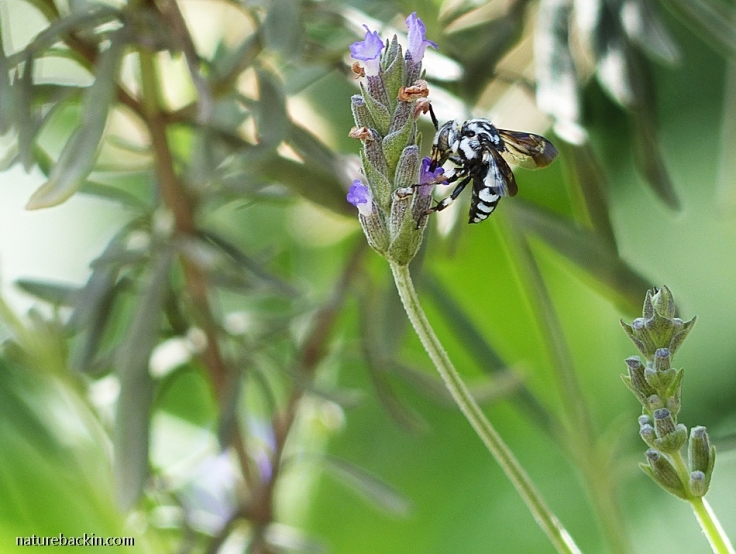
Adult cuckoo bees feed on nectar from flowers, but they lack pollen collecting (and nest building) abilities
Cuckoo bees are not numerous enough to threaten the species survival of their hosts, but unfortunately there are many real threats to the survival of pollinators, including bees. The decline of honey bees gets a lot of media attention, but numbers of solitary bees too are on the decline. Loss of bee diversity is not only a threat to natural ecosystems, but also to agriculture.
Most solitary bees collect pollen on specially adapted brushes of hairs on either their abdomens or legs. As this pollen is more easily shed when visiting other flowers than the pollen collected by honey bees that is packed into sacs on their legs, solitary bees are more effective pollinators of the plants they visit than honey bees.
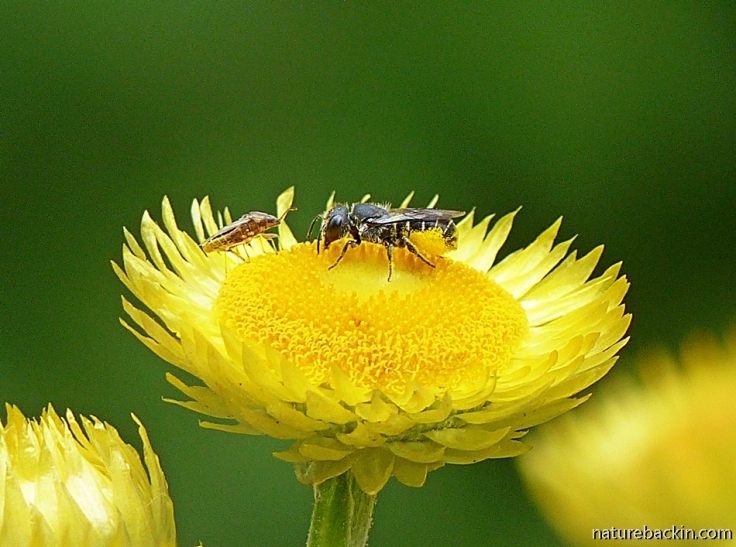
An unidentified solitary bee visiting an Everlasting flower in our garden, alongside another insect (on the left) that I also have not identified. Because the pollen is adhering to the abdomen of the solitary bee, as can been seen in this photo, I would guess that this bee is a member of the Megachilidae family
Plant diversity depends on pollinator diversity, and the conservation of pollinators is important for our food security and survival. Ongoing threats to bees include the destruction of nests, nesting material and nesting sites. For example, removing dead trees and the widespread collection of firewood can have a detrimental effect on species of solitary bees that nest in wood. Commercial bee keeping can potentially introduce pests and diseases to wild species of bees. Agricultural activities can destroy or make unavailable sites used by ground dwelling bees, both through tilling and sites being trampled by livestock. Flowers that are sprayed with insecticides can kill adult pollinators directly or contaminate the food they collect for feeding their larvae. Polluted water is another threat to bees and where natural water sources are replaced by reservoirs and canals, mud sources for nest building are less available for bees. Agricultural monoculture and destruction of habitats and plant diversity are major threats to bees worldwide.
Farmers can take action to mitigate some of these threats. For example, farmland can leave narrow (1-metre) strips of land to provide diverse vegetation and provide year-round food resources for bees, and provide nesting, breeding, resting and refuge sites for bees. Pesticide use on flowers should be minimised or adjusted so that farmers avoid poisoning pollinators, and pesticide drift to neighbouring areas should be reduced as much as possible (BioNET-EAFRINET, 2011).
Home gardeners too can take steps to make their spaces more accommodating to bees. There is a welcome and growing interest in setting up bee houses suitable for some species of solitary bees to nest in, but planting a diversity of plants, including plants that are native to the area, should also be part of the plan to help pollinating bees survive and breed. Ensuring potential nesting material simply by not creating a sterile garden, and leaving at least some corners in the garden to grow naturally and so be suitable for nesting sites, including for soil nesting bees, are also easy habits to get into. I was touched to read this eloquent plea to gardeners to conserve mining bees: Let mining bees be.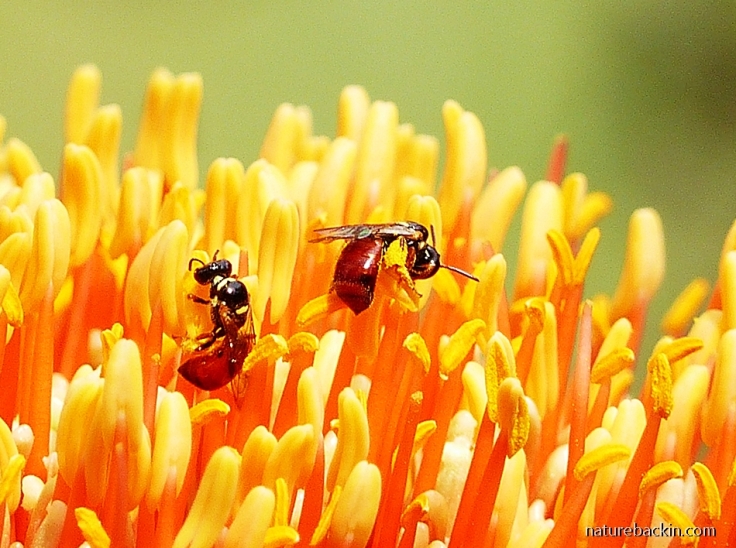
Small carpenter bees (Allodapula variegata) on a flowering Paintbrush or Snake Lily (Scadoxus puniceus). The bees are collecting pollen that adheres to fine brushes of hairs on their legs
There are some species of bees that are more generalist than others in the plants they visit. Generalist bees include honey bees and bumble bees. However, studies have shown that even bees with generalist potential learn which plants to visit and that they tend to make repetitive visits to the same plants. Even generalist bees cannot pollinate all types of plants.
Some solitary bees are fairly generalist in the plants that they visit, others visit only a narrow group of plants, and a few specialist species are restricted to pollinating only a single species of plant. The other side of the coin is that some plants have evolved to be pollinated by specific species of pollinators only.

A carpenter bee (Xylocopa caffra) visiting an African Dog Rose in our garden. Large carpenter bees are often mistakenly referred to as bumblebees, but there are no South African bumblebees
Studies in the field of plant-pollinator interactions are ongoing. It stands to reason that the more diverse plant communities are, the more species of pollinators can be sustained, and that more complex networks of pollinators and plants are likely to be more sustainable and resilient should any one species be compromised in any way.
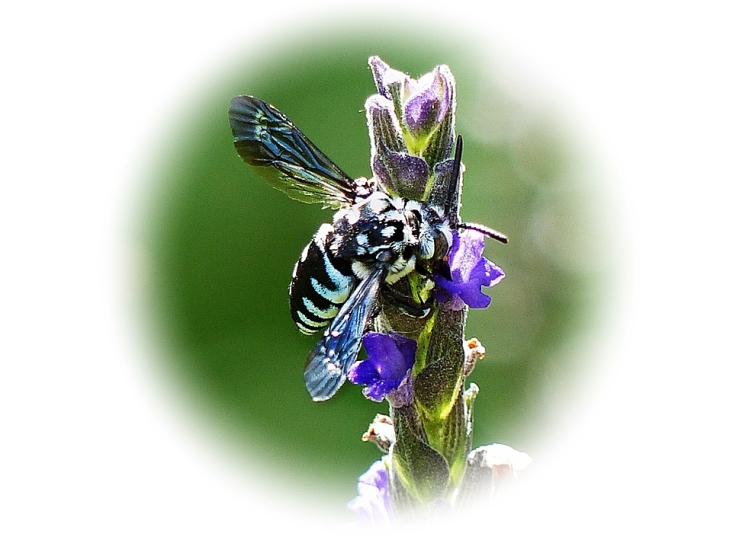
Sources:
BioNET-EAFRINET. 2011. Keys and Fact Sheets: Megachile bees. https://keys.lucidcentral.org/keys/v3/eafrinet/bee_genera/key/african_bee_genera/Media/Html_eafrica/Megachile_bees.htm
Eardley,Connal. [n.d.] Bees at the Pafuri River Camp. http://www.pafuri.co.za/bees.php
Eardley, Connal; Kuhlmann, Michael & Pauly, Alain. 2010. The Bee Genera and Subgenera of sub-Saharan Africa. ABC Taxa, vol.7. http://biodiversityadvisor.sanbi.org/wp-content/uploads/2012/11/bee-genera-of-SA.pdf
Gous, Annemarie; Willows-Munro, Sandi; Eardley, Connal & Swanevelder, Zacharias H (Dirk). 2017. Pollination: Impact, role-players, interactions and study – A South African perspective. South African Journal of Science, 113 (9-10). http://www.scielo.org.za/scielo.php?script=sci_arttext&pid=S0038-23532017000600010
Grow Wild: Flowers to the People. [n.d.] About Solitary Bees. Kew Royal Botanic Gardens. https://www.growwilduk.com/content/about-solitary-bees
Spence, Steven. 2016. Parasitic Bees: Natural-Born Robbers. GotScience Magazine. https://www.gotscience.org/2016/08/parasitic-bees-natural-born-robbers/
Posted by Carol









February 8, 2019 at 11:26 am
thank-you and you’ve improved my knowledge of bees 🙂
LikeLiked by 1 person
February 9, 2019 at 12:40 pm
And thank you. Honey bees seem to get all the media attention don’t they?
LikeLike
January 27, 2019 at 12:08 am
Excellent picture.
LikeLiked by 1 person
January 27, 2019 at 8:18 pm
Thanks very much.
LikeLike
November 28, 2018 at 9:59 am
Thank you Carol for your unique and lovely documentation! xxx
LikeLiked by 1 person
November 29, 2018 at 6:09 am
Thanks so much Christeen. Seems I am learning new things every week as I try to be more aware and observant!
LikeLiked by 1 person
November 17, 2018 at 4:05 am
Lots of great information and photos, as always. I’d heard of cuckoo wasps before, but not cuckoo bees. Let’s hope that efforts to improve the lot of bees is successful or we’ll all be the worse for it.
LikeLike
November 17, 2018 at 2:43 am
Wonderful post (as always)! I enjoy the lessons I learn here at your blog so much. I have much work to do here at the house I moved to just over a year ago. I’ve been researching native plants for this area and waiting for a bit of rain to start planting. Sadly our rain is seriously overdue!
LikeLiked by 1 person
November 17, 2018 at 6:19 pm
Hope you get rain soon. So worrying and even more so in the aftermath of the California fires, which are still ongoing as far as I know.
LikeLike
November 17, 2018 at 8:37 pm
We’re expected to get some rain come Thursday. How much is the big question. So far it’s been a few (mighty few) sprinkles that haven’t amounted to much. We are just barely north of the California border and sharing much of their drought. Just last week we had a couple of close calls when people burned some “slash”. If you’re not familiar with the term it’s branches and undergrowth that’s been piled up waiting for the rains. Burning seems to be restricted by date, so restrictions were lifted at the beginning of the month even though we haven’t had anything close to the normal amounts of rain we should have had. Luckily our amazing firefighters kept the fire from spreading where it might have taken out at least one town, possibly another (much like the California Camp Fire). That’s far too close for my comfort. Luckily someone woke up (figuratively) and put fire restrictions back in place.
Sometimes some folks’ ignorance is past my understanding.
I haven’t heard the latest updates, but I suspect it will be awhile yet before the Calif. fires are totally out. It could even go until the rain finally arrives, but at least they’re keeping it from burning populated areas -which are relatively scattered in the Sierra foothills.
LikeLiked by 1 person
November 20, 2018 at 9:17 am
How crazy to have lifted the restrictions, but folks should know better anyway than light such fires in current conditions. Hoping you have had at least some rain.
We have had high temperatures here, but promise of rain tomorrow, which will be good. Ongoing weather extremes mean nothing can be taken for granted …
LikeLike
November 16, 2018 at 8:36 am
Here’s another of your readers who had never heard of cuckoo bees – or indeed many other varieties of bee. I’m ashamed to realise how many varieties we have even in the UK which I am unable to distinguish from each other. Must try harder!
LikeLiked by 1 person
November 16, 2018 at 6:57 pm
There’s a whole other world out there 🙂
LikeLiked by 1 person
November 16, 2018 at 7:00 am
Never heard about cuckoo bees! I love to read about the diversity of insects in other parts of the world! Amazing pictures, Carol!
LikeLiked by 1 person
November 16, 2018 at 8:09 am
Thanks so much Simone. Insect diversity is so fascinating.
LikeLiked by 1 person
November 16, 2018 at 3:00 am
I always look forward to your posts. This one is particularly interesting – I have not noticed such a bee in my garden and will keep a look out for one. Your photographs are wonderful.
LikeLiked by 1 person
November 16, 2018 at 6:50 am
Thank you Anne. Lovely to hear that you enjoy my posts. From week to week I have no idea what to post about, so its nice when an unexpected visitor, such as the cuckoo bee, introduces me to a new subject to explore. I would be interested to hear if you do spot a cuckoo bee in your garden (or elsewhere).
LikeLike
November 16, 2018 at 1:50 am
Another terrific article, Carol – it must have taken you quite a bit of time to research? Thank you very much!
LikeLiked by 1 person
November 16, 2018 at 6:48 am
Thanks very much. I enjoyed doing a bit of reading about these interesting bees and sharing what I found. I admit I do tend to get a bit carried away, but generally the demands of real life put an end to my rather eclectic investigations 🙂
LikeLiked by 1 person
November 16, 2018 at 12:22 am
Superb photos!
LikeLiked by 1 person
November 16, 2018 at 6:43 am
Thank you for your kind comment, Belinda.
LikeLike
November 15, 2018 at 9:14 pm
Great shots and interesting facts – never heard of cuckoo bees for example… I try to plant the right plants and flowers for them and support with water and possible nesting places. There is much talk about the disaster of losing bees. Everyone must help.
LikeLiked by 1 person
November 16, 2018 at 6:39 am
Thanks so much Leya. I also had not heard of cuckoo bees before. I really enjoyed finding out a bit about them. I am hopeful that more of us with gardens (and even balconies) try to plant for bees and other creatures and support them in other ways too. If everyone helped imagine the difference that would make!
LikeLike
November 16, 2018 at 3:20 pm
♥
LikeLiked by 1 person
November 15, 2018 at 9:03 pm
.
Indeed this is a cuckoo bee. It’s regarded as an Old World bee – Thyreus. A real beaut, Carol.. And smashing photos
They are beginning to show up at our spot now the weather is warming up.
As you mentioned the strong jaws of their larvae, you might find this interesting.
https://attaleuntold.wordpress.com/2017/01/26/beeing-there-just-parking-off/
LikeLiked by 1 person
November 16, 2018 at 6:36 am
Thanks Ark. Your post on the sleeping/resting bee is really interesting. Thanks so much for the link. I gather cuckoo bees are seldom aggressive as they have no worries about protecting a nest and babies! I thought the cuckoo bee might be a Thyreus pictus, but then saw a photo of a Afromelecta fulvohirta – very similar! I also read that ID-ing cuckoo bees is tricky, so I decided to err on the side of caution!
LikeLiked by 1 person
November 16, 2018 at 7:53 am
Likewise, I’ve never felt threatened or been the object of any outwardly aggressive behaviour,but as with all our garden friends … respect!
LikeLiked by 1 person
November 16, 2018 at 8:14 am
I so agree, and I do believe that respect engenders a degree of reciprocity. And anyway it is so much nicer to stand back and see animals that are confident and relaxed, rather than bustle in and see animals that are afraid and defensive, or simply disappearing as fast as they can.
LikeLiked by 1 person
November 15, 2018 at 8:50 pm
Great post, Carol. I like that you offered specific ways to help bees, something everyone can do. We all need to lend a hand.
LikeLiked by 1 person
November 16, 2018 at 6:28 am
Thanks Eliza. I think that lots of us making a difference in even small spaces has the potential to add up to a sustaining network.
LikeLike
November 16, 2018 at 10:35 am
Agreed.
LikeLiked by 1 person
November 15, 2018 at 8:32 pm
Amazing post with sharp photography 💚
LikeLiked by 1 person
November 16, 2018 at 6:24 am
Thanks very much 🙂
LikeLiked by 1 person
November 15, 2018 at 8:08 pm
I had no idea there were so many species of bees worldwide. Pretty amazing!
LikeLiked by 2 people
November 15, 2018 at 8:20 pm
It is a amazing, and was news to me too!
LikeLiked by 1 person